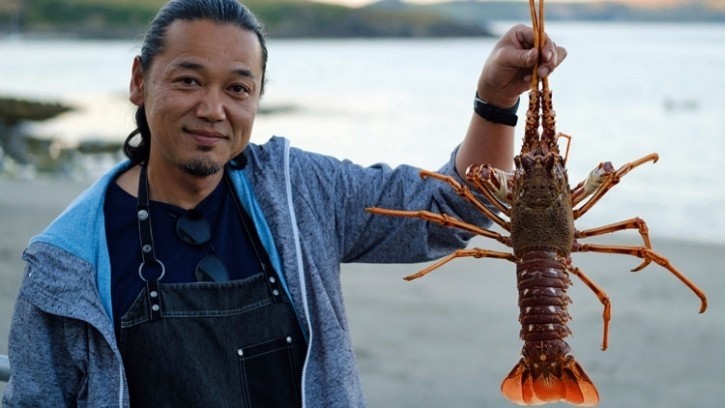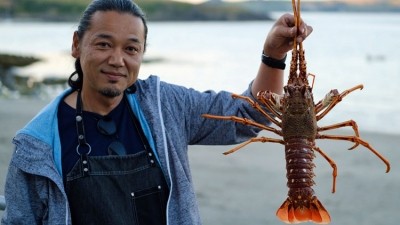Masaki Sugisaki: “I won’t buy from fishermen I haven’t been out on the boat with”

Tell us about your Gill-to-Tail at Dinings SW3 dinner series
We wanted to highlight the importance of sustainability and collaborate with like-minded people. At Dinings SW3 we champion sustainable seafood and the fishermen that catch it for us. We also ensure we use every bit of it. The chefs we have coming to cook are Emily Chia from Sargasso (in Margate), Roberta Hall-McCarron from The Little Chartroom (in Edinburgh), Joe Baker from Pêtchi (in Jersey) and finally Dan Cox from Crocadon (in Cornwall). The series launches at the end of the month.
How will the dinners work?
There will be between 10 and 12 courses. The guest chef and I will choose three or four species and we’ll each serve our own take on them. We have picked each chef because they care about sustainability but also because they come from an area of the UK that has great seafood. If weather permits they will bring the fish with them. Because we all want to stick to our ethos of only cooking with what is high-quality and sustainable we have no idea what we are going to be cooking with at this point. It all depends on what the fishermen catch, which is exciting.
Where do you get your seafood from?
The majority of our seafood now comes from Cornwall. A few years ago, we went down to Cornwall and camped out at a pub close to the port in Newquay. We’re still working with the same group of fishermen we met that day. They were selling a lot of their catch into the foreign market at a relatively low price. We offered to pay double if they could handle the fish in a certain way and get it to us quickly. In some cases, they are now using the ike jime method (a traditional Japanese slaughter technique that sees the fish killed instantly and thoroughly bled).
How do you ensure the people you work with are fishing sustainably?
I won’t buy from fishermen I haven’t been out on the boat with. I want to see how they catch it and I also want to have a detailed chat about their ethos. Some people are catching whatever they can; they aren't that interested in either quality or sustainability. But the fishermen we work with are passionate about fishing in a sustainable way and they also comply with all rules around quotas, size and seasonality. They are all dayboat fishermen that generally catch their fish by line. We don’t work with people that dredge.
Tell us about some of the less obvious species you use
One of my favourite things to use at the moment is spiny lobster. They are rarely seen in UK restaurants, partly because at one point they were being overfished. The meat has a firmer texture than native lobster and a more intense flavour. While there is much less demand, it's unfortunately more expensive than native lobster because it's caught in small nets rather than creels (which is more labour intensive) and it's also found much further out to sea so more fuel is required. Another unusual species we have access to is conger eel. The flavour is amazing but they are difficult to work with because they are big and very bony.
What are the main difference between how fish is treated in the UK and Japan?
Fishermen, suppliers and chefs treat fish more carefully. For example, in Japan fish is always stored in a way that protects the top side of the fillet. Traditionally, this is used for more delicate things like sushi and sashimi whereas the bottom side of the fillet is used for grilling and braising.
Do your guests appreciate the lengths you go to?
Absolutely. It’s something we talk to our guests about a lot and they are interested, our regulars in particular. There are lots of good Japanese restaurants in London now. When you're at our level, the quality of the ingredients makes a big difference. Japanese food is very simple, a lot of the time the only difference is the quality of the produce and correct technique.
Dinings SW3 is a high-end place. Does that make it hard to use every bit of the fish?
Not really. In the West using every bit of the fish is a relatively new concept but that is not the case in Japan. One of the key philosophies of our cooking is to pay maximum respect to the ingredient. It is something that is drummed into young Japanese cooks from the start. At the moment, we’re serving the deep-fried bones of small fish including mackerel as a snack, they’re delicious and really good for you. We also use the shells of crustaceans and fish bones and offcuts to make a special concentrated dashi that we use to make croquettes.
Tells us about your background
I was born and raised in a restaurant. My parents had a kaiseki place in Tokyo and I was pretty much forced to work there as a teenager. It is traditional that the eldest son takes over the family business but I didn’t want to do that so I moved to the UK to study in my early 20s. But looking back I really appreciate all the things my parents taught me.
How did you get back into restaurants?
I worked part time in a few small Japanese restaurants in London to support my studies. Back in the 1990s there wasn’t much good Japanese food in the capital. I loved living in London, and after a while I realised that there would probably eventually be an opportunity to open something that was more authentic. In 2000 my parents asked me to take over their restaurant. Returning to Japan did not work out because I had grown used to the freedom I had enjoyed in London. Japan is a very traditional place with a lot of rules. A few years later I got an opportunity to be part of the opening team at Nobu Berkeley Street. I opened the original Dinings restaurant in 2008.
Tell us about the Dinings SW3 concept
We offer Japanese fusion, but the techniques and the ideas are authentically Japanese. The reason we went down that route is that back then London wasn’t ready for traditional Japanese cuisine. It would be very difficult to open an authentic kaiseki restaurant even now. But over the past 15 years we have gradually made the menu more traditional and will continue to move in that direction.































